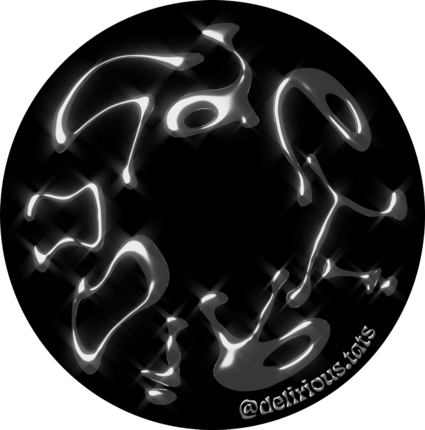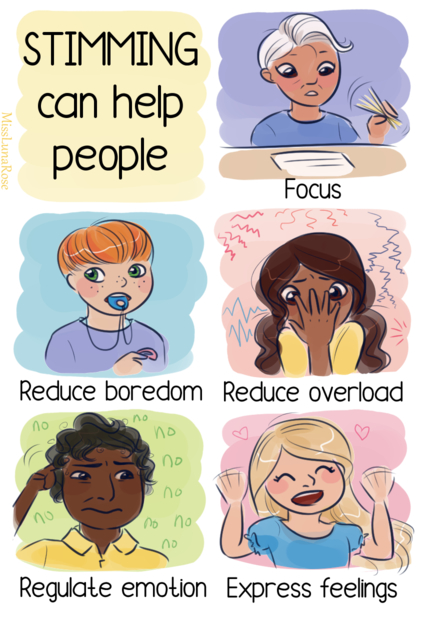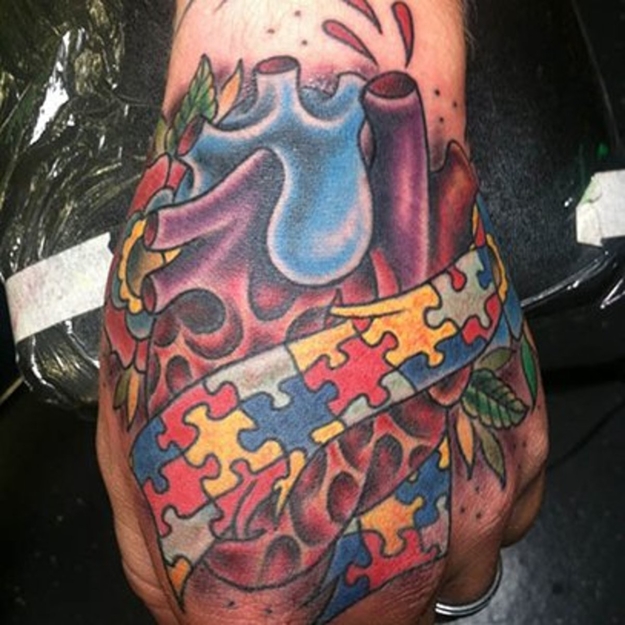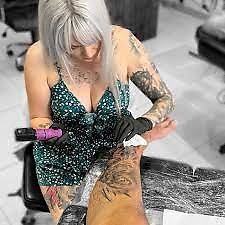@delirious.tats Logo - Credits: @delirious.tats
The Links between Tattoo Culture and Autism
Beautiful stimming; the experience of getting a tattoo and giving a tattoo as an autistic person
Our latest interest within the A/artist Project is researching the link between the tattoo culture and autism. The idea came up when I mentioned in my interview at Mediamatic that I am enthusiastic about stick and poke tattoos (@delirious.tats) can be a form of stimming. Willem loved the idea and so we launched ourselves into research, which I will share in this blog post.
We organised a round table, a workshop (keep an eye out on our workshop calendar) and hopefully a public event around the subject. Furthermore, we are thinking of linking it to the topic of body modification in general.
Thus, what you're reading now is only the beginning of a bigger project.
Framework
In the DSM-5, four symptoms of autism spectrum “disorder” are used to evaluate the severity of the “disorder”. One of those is listed as “Stereotyped or repetitive motor movements, use of objects, or speech (e.g., simple motor stereotypies, lining up toys or flipping objects, echolalia, idiosyncratic phrases).” In research, this symptom is generally known as autistic stereotypy or self-stimulatory behaviour. Generally - as implied by the fact that it is listed as a symptom - the clinical aim is to decrease stimming. Within this line of thinking, autism - and stimming - is set within the pathology paradigm. Naturally, such a paradigm results in stigma and thus with oppression of autistic people, as they argue that it takes away from their bodily autonomy and their right to self-expression.
I - as many other neurodiverse people - advocate for the neurodiversity interpretation of all behaviour, including autistic behaviour and therewith stimming. Neurodiversity, as defined by the Autistic self-advocate Nick Walker, is “the understanding of neurological variation as a natural form of human diversity, subject to the same societal dynamics as other forms of diversity,” such as race, gender, ethnicity or sexual orientation. This reasoning is known as the neurodiversity paradigm in which all variations of neurodivergent behaviour can be contextualised as being natural and healthy. In this paradigm, a deviation from the norm is not a disorder, thus allowing for the abolishment of such dichotomous thinking. The neurodiversity community has reclaimed the symptom and given it the name “stimming”. Hence, we will not regard stimming as a symptom of a disorder, but rather a manifestation of neurodiverse variation. In this sense, we want to promote stimming and research its link to art, specifically in the form of stick and poke tattoos.
Stimming
Research is not sure why stimming occurs. Some scholars argue that it occurs due to hyposensitivity (understimulation), while others maintain that stimming is a by-product of hypersensitivity (overstimulation). Mostly, researchers conclude that stimming is a way to reduce anxiety. Stimming provides a consistent, self-induced and therefore predictable sensory input, as opposed to the external, often unpredictable and mostly overwhelming sensory input. It allows people to attend to one self-induced point of focus while blocking out excessive input. Moreover, stimming has been found to help with learning and concentration. In this sense, we can understand stimming as a way to regulate one’s emotions, which are thus not something one should aim to decrease.
The neurodiversity paradigm evidently argues that stimming is neither dangerous nor inappropriate - that is when the stimming activity is non-harmful, excluding i.e. nail biting and potentially redirected into fidgeting for instance. Autistic people share that stimming is a way of self-regulation and even self-expression that can lead to wonderful outcomes, such as music and tattooing.
Moreover, researchers argue that stimming might even be a form of social interaction.
Productive Stimming
I hope that this account makes it clear that stimming helps autistic folks to cope in a neurotypical world. In order to decrease the stigma around stimming and increase autistic people’s well-being, our goal is to show how stimming can be beautiful and even result in art. This is why we are organising a stick and poke tattoo workshop in the name of organised stimming: rhythmically and repetitively poking a hole into skin. From reading reports on stimming from autistic people, it’s obvious that they try to express stimming in a way different from their intuition in order to conform to what is socially acceptable. Whether or not they choose to suppress stimming depends on the understanding of stimming and autism in their environment. Imperatively, our goal at Mediamatic is to not only encourage “productive” stimming, but every form of it - that is if the activity does not cause collateral damage such as skin damage in skin picking. The aim of the tattoo workshop is to draw attention to the importance of stimming and to connect it to our effort to link autism to art.
What we face, then, is the “double empathy” problem where autistic people usually have to meet neurotypical people’s expectations with the lack of reciprocity from the latter. I.e. repress stimming to fit into the neurotypical world instead of the latter accepting stimming to accommodate the neurodiverse world.
Getting a Tattoo as an Autistic Person
The Challenges of Getting a Tattoo as an Autistic Person
Purple Ella - an autism activist - shares her story of her first machine tattoo in a tattoo shop on her Youtube Channel. She mentions her experience that can be framed as being typical of autism.
First of all, she has a needle phobia which occurs significantly more in autistic people, compared to the general population.
Secondly, it is clear throughout her account that she has high levels of anxiety with regards to an experience from which she does not know what to expect. This translates into her gathering all possible information that she can find on how a tattoo appointment works, what the sensation is like, tweeting and googling for hours. One could say that it is typical for autistic people to be overwhelmed with a social situation for which they do not know the script. A lot of autistic people want to feel prepared as much as they can in all situations, due to the feeling that the outer world is so unpredictable and oftentimes overstimulating in itself. This is also due to the fact that social interactions do not come naturally to them, some want to learn the script ahead of time, as a way of masking. Getting a tattoo combines both the uncertainty of a new sensation (which for many autistic individuals is terrifying because of pre-existing sensory issues) as well as the cluelessness regarding a new social script. For Purple Ella, those feelings resulted in a sort of hyperfocus - again typical for autistic people - to gather as much information as possible as well as to share every bit of advice possible with her audience, in order to protect them from unplanned occurrences. Quite typically, she is very overwhelmed when there are things coming up with the tattoo that she did not know about.
A third interesting point she makes is that in order to not chicken out, she tweeted publicly that she would go to the tattoo shop. Even though it is not true that autistic people do not have any intrinsic motivation whatsoever, they can feel frozen because their amygdala - the part of the brain that is responsible for anxiety - is overactive and enlarged. This heightened anxiety, combined with alexithymia - which is not knowing how you feel affectively - can lead autistic people to overthink every decision cognitively. They often do not have a general gut feeling or intuition like neurotypical people, and if they do it’s blurred with anxiety. Hence, they tend to work better with extrinsic motivation, because it is like giving the responsibility to someone else to make the decision for them. In this case, Purple Ella was clearly extremely anxious and not able to trust her intuition. By telling Twitter that she is in the tattoo studio, she builds external pressure by setting a decision publicly, thus taking the noise out of her mind and into the world which she does not want to disappoint.
The Benefits of Getting a Tattoo as an Autistic Person
Pride / Reward
Purple Ella shared that she would like to get another tattoo, due to the overwhelming pride she felt after having it done. Aspie World on Youtube shares this experience as he mentions that getting a tattoo is extremely rewarding as in the process, pain turns into a picture, which he says can become addictive. He sees the body as a canvas and does not share any of the overthinking and anxiety that Purple Ella did. Perhaps because he is used to the process by now?
Sensory Pleasure
The Aspie World makes a very interesting claim: he says that for him the process of getting a tattoo is comforting. He - like many other autistic people - has sensory overloads from soft touching on his skin.
However, the hard pressure of the tattoo, as well as the humming noise of the tattoo gun to which he would stim to are comforting and pleasurable to him. It is generally established that there are two types of touch to which autistic people tend to react differently. On the one hand, the procritic touch system is light and might evoke autistic people’s fight or flight response in order to warn them from harm. The epicritic deep touch system, on the other hand, establishes a sense of security by alerting you of where your body is in space without looking. Getting a tattoo is clearly part of the epicritic deep touch system and thus perhaps an enjoyable experience to autistic people with such sensory issues. Tattoo artists on inkedmag mention that the right combination of discomfort and pain while getting a tattoo feels pleasurable.
That is because many autistic people are also sensory-seeking, as evidenced by self-harm reports higher than in the general population. In that sense, getting a tattoo is reported to be a non-dangerous stim. It is explained that processing the strong emotional and physical experience of getting a tattoo feels liberating.
Within this framework, an article on 4thwall.net explains that autistic people might seem withdrawn, but not because they are disconnected from the world, as the stereotype holds. Quite on the contrary, they are too connected to the world in the sense that they have a minimal filter which results in a constant flow of information. Being withdrawn is thus an effort to moderate input. In this case, the experience of many autistic people is said to exist in the “intense world theory”. This can result in sensory overstimulation to a point that one loses perception of one’s own body where the borders of the self are skewed and a disconnection between mind and body occurs. Tattooing can facilitate the reintegration process, thanks to the pressure, focus and pain.
Aesthetics
The article by inkedmag.com elucidates that getting tattoos translates into living out your special interests. Moreover, it is said that autistic people do not care about their appearance and break social boundaries, thus perhaps being more likely to get tattoos than the general population. Through getting a tattoo, they can thus live out their aesthetics in daily life without the cognitive overload that might result from daily outfit choices.
Hoarding
Another interesting claim is that tattoos are a fun thing to collect, which falls within research reporting that autistic people are more likely to be hoarders than the general population. Within this framework, it is also mentioned that autistic people are averse to change and will not stop loving their tattoo, i.e. not regret their design.
Giving a Tattoo as an Autistic Person
Tattooing aids Autism
Give back to Society / Escape
The autistic tattoo artist Charl Davies on Youtube explains that for her, tattooing translates into giving something positive back to a society which she’s not part of. To her, autism is to struggle to live in the real world but to excel in one’s own. The latter for her is tattooing and drawing which is not only a hobby, but a way of survival which helps her to function. It is also a way to gain back control; she feels like she can’t control many things, but she can always control her art. Within the inkedmag article, a similar account to the one by Charl Davies recounts that tattooing is a form of escape into one’s own imagination where no pressure or rules rule.
Being Your Own Boss
An article on inkedmag.com reports interviews of autistic tattoo artists. The general consensus is that being your own boss is a great plus for tattoo artists. It allows them to have their own light/noise settings, leave whenever they feel overstimulated, etc.
Autism aids Tattooing
For autistic tattoo artists, it's not just that tattooing aids their autism as a form of stimming, their autism also aids their tattooing. Many of the artists agree that being an autistic tattoo artist is beneficial in that they are quite perfectionist or even obsessive, which makes them great at their job. Additionally, many autistic people have the capacity to hyperfocus, which makes them great at work, yet exhausted afterwards. Moreover, it is shared that their logical reasoning benefits their clients as they excel at helping indecisive people decide (even though they might be indecisive themselves). Additionally, autistic people tend to think outside the box, which translates into having a more interesting and new approach to tattooing and designing given that they do not have a target audience in mind, but do it for themselves. Generally, the tattoo artists mention that their focus is on creating a pleasurable experience for both the client and themselves rather than about the outcome, which highlights the passion for their work. Within this same line of thinking, another artist mentions that autistic people have a unique relationship to patterns, aesthetics, colour and light, which they can express through tattooing.
Moreover, throughout the inkedmag article, it is generally stated that being autistic translates into being more empathetic towards the anxieties that clients might have, as already suggested by Purple Ella.
Additionally, in line with what I found in my general research regarding autism and art, it’s been reported that tattooing is a way to communicate non-verbally - which autistic people always look for according to this artist - and to modify the world to be a more pleasurable sensory experience through touch by getting a tattoo, hearing of the machine or poking, and seeing the drawing. This combination puts autistic people at a favourable position to be great tattoo artists.
My Personal Experience
For me, stick and poke tattoos functions as an escape from an always busy and oftentimes anxious mind that might come from ADHD and autism. When tattooing, one completely lets loose and enters a zone of peace which I don't get to experience often. I see stick and poke as stimming as one repetitively pokes every individual hole into someone's skin, which is extremely calming. Moreover, given that it is applied (as opposed to autonomous art), I feel like one can give up control and trust that the person who is being tattooed. In the end, it's them who have to agree with the design and not the artist who has to make the final decision, which adds to more peace.
Stick and Pokes is a form of tattooing, different to tattoos made with gun. They are also called hand poke tattoo, because the artist holds one single needle that they put into the skin, dot by dot. Thus, generally this form of tattooing necessitates more layers as the hand is slower than the machine that shoots dots at a rate faster than what the eye can see. By: Lynn (she/they) Clemens
Conclusion
From this account, I hope it becomes apparent how beautiful stimming can be and how autism can translate into art, specifically tattooing.
I further investigated the hypotheses I made in this article through my workshops, please read here.
Further References
Bakan, M. B. (2014). The musicality of stimming: Promoting neurodiversity in the ethnomusicology of autism. MUSICultures, 41(2).
Kapp, S. K., Steward, R., Crane, L., Elliott, D., Elphick, C., Pellicano, E., & Russell, G. (2019). ‘People should be allowed to do what they like’: Autistic adults’ views and experiences of stimming. Autism, 23(7), 1782-1792.
Lacour, K. (2018). The Value Of Art Therapy For Those On The Autism Spectrum. The Art.
Yasuda, Y., Hashimoto, R., Nakae, A., Kang, H., Ohi, K., Yamamori, H., ... & Takeda, M. (2016). Sensory cognitive abnormalities of pain in autism spectrum disorder: A case–control study. Annals of General Psychiatry, 15, 1-8.


